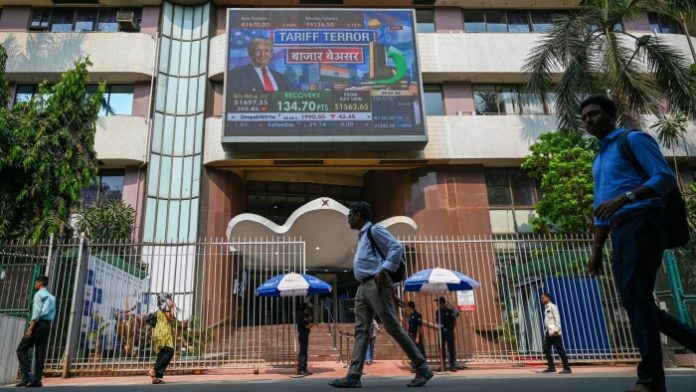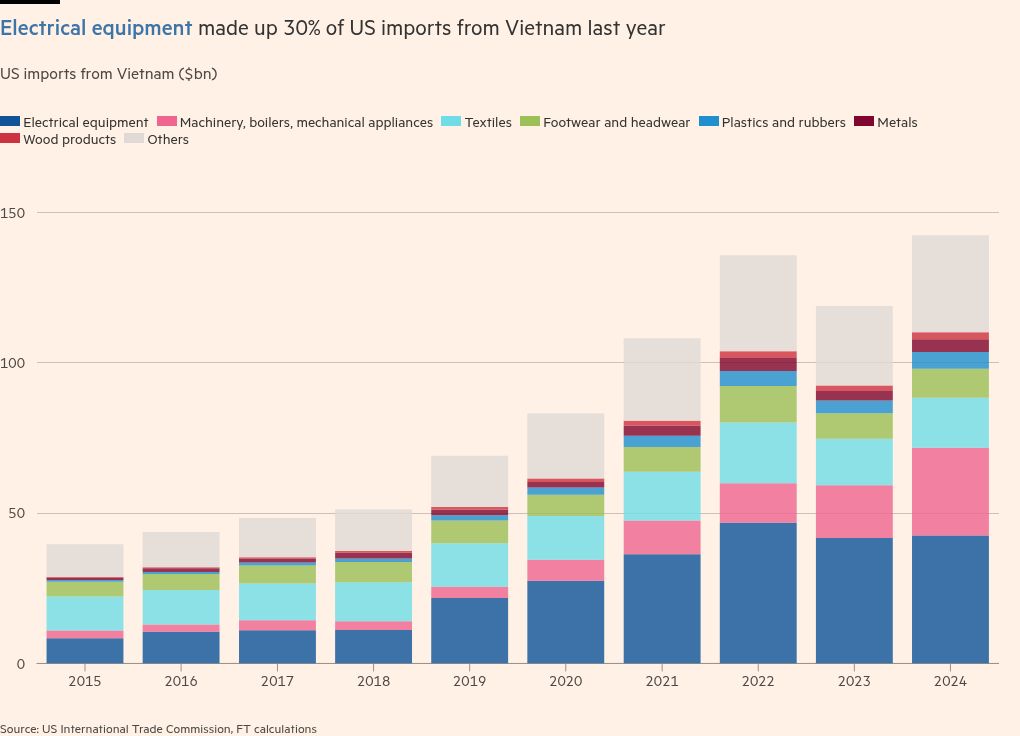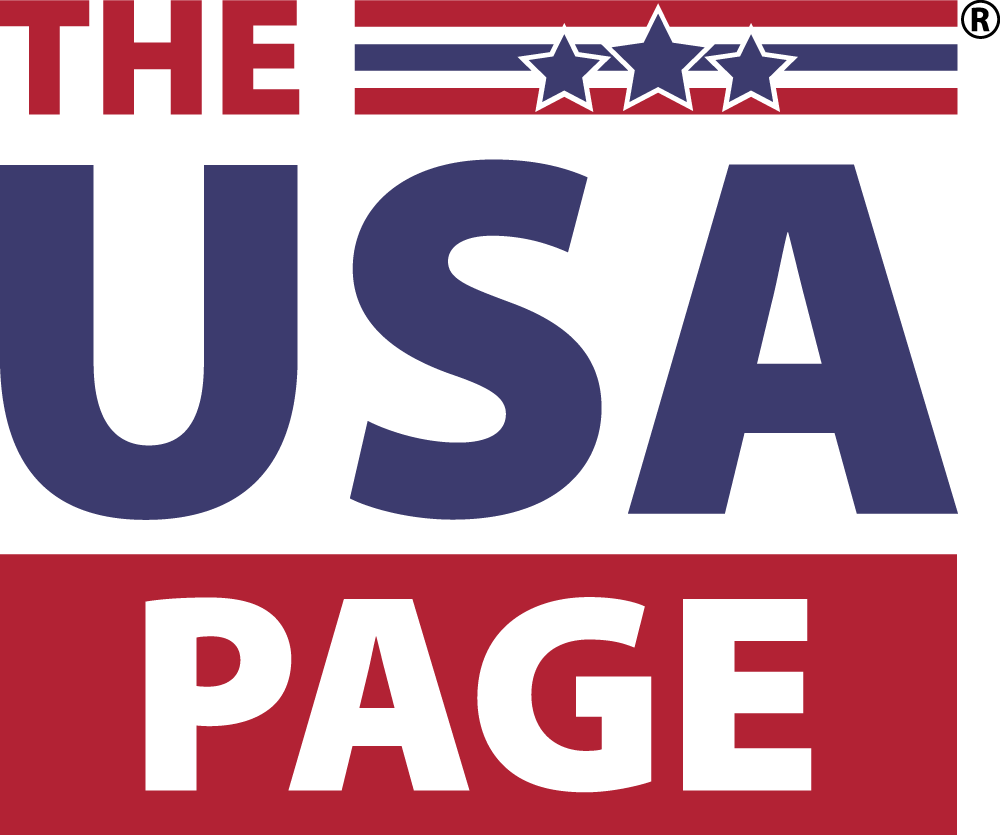President Donald Trump’s barrage of tariffs is set to land hardest on Asian manufacturing, throwing into disarray supply chains rejigged only recently to work around tensions with China, according to executives and analysts.
The Trump administration’s “reciprocal” tariffs bring the rate on imports from China to more than 60 per cent, representing the highest levels in the region.
But manufacturers and economists said new tariffs of between 32 and 49 per cent on many south-east Asian economies come as a much bigger shock, undermining the “China plus one” strategy of using them as a second export manufacturing base.
“The tariffs hit ‘Factory Asia’ hard,” Citi analysts said in a research note.
After Trump punished China with tariffs during his first term in 2018, scores of manufacturers, most notably in electronics, started shifting production to south-east Asia and elsewhere.
Vietnam, the first and largest beneficiary of that trend, is expected to be the worst hit now: it faces a 46 per cent tariff rate and is more exposed to the US market than most other Asian exporters.
“The . . . impact would be the worst for Vietnam given US exports account for 30 per cent of its GDP,” Bernstein analysts said, adding that the new tariffs could shave up to 6 per cent off the country’s output.
Vietnam and south-east Asia have also become a conduit for Chinese goods to the US. Nearly one in three new investments in Vietnam is from Chinese companies.
“China’s prior strategy of routing exports through Asean may now be less effective, with reciprocal tariffs on countries like Vietnam and Thailand even higher than those on China,” OCBC analysts said in a research note.
“As a result, the trade dynamic may shift again, potentially driving China to pivot more of its exports directly to North America, despite the broader tariff environment.”
Electronics gadgets, including smartphones, computers and electrical equipment, which accounted for 30 per cent of Vietnam’s exports to the US last year, are expected to take the biggest hit.
Supply chains for clothing and shoes, with Vietnam the largest source of US imports after China, are also expected to be disrupted.
Industry executives said Chinese electronics contract manufacturers Luxshare and Goertek, which have invested heavily in Vietnam since the 2018 tariffs on China to manufacture for Apple and other multinational brands, would have to move or add capacity elsewhere yet again.
Japan’s Nintendo has been shipping hundreds of thousands of its new Switch 2 games consoles from its Vietnamese facilities to the US, while South Korea’s Samsung, the second-largest mobile phone brand in the US after Apple, now has 45 per cent of its smartphones manufactured in Vietnam, according to Taipei-based electronics research firm TrendForce.
Some observers see an opportunity for India, which got off comparatively lightly, with a 27 per cent tariff rate.
“Taking into account the pressure of tariff costs, Samsung will still focus on Vietnam as its main smartphone production base in the short term, but will accelerate its production expansion plans in India to prioritise meeting the North American market,” said TrendForce analyst Mia Huang. “This wave of tariff measures will help India accelerate the development of its smartphone supply chain and take on more production orders.”
Compared with the higher combined tariffs China and Vietnam are facing, India would enjoy a “valuable near-term window of export competitiveness”, Pankaj Mohindroo, chair of the India Cellular & Electronics Association (ICEA), told the Financial Times.
However, Mohindroo said, the “true long-term inflection point” for India’s electronics industry would rest on the successful conclusion of a US-India bilateral trade agreement, the first tranche of which the two countries have vowed to agree by autumn.
During Prime Minister Narendra Modi’s visit to the US last month, the two countries pledged to increase their bilateral trade in goods and services to $500bn by 2030, up from less than $200bn now.
Analysts said that many large manufacturers such as Taiwan’s Foxconn, the world’s biggest iPhone maker, or Quanta Computer, the leading manufacturer of laptops which also assembles servers for many US clients, would be able to cope with the “liberation day” tariffs. They and other contract manufacturers have added plants in south-east Asia, Mexico and the US itself since 2018, and are moving to increase production in the US.
Despite the wave of tariffs on products imported to the US, “you still need the facility [abroad] because you still don’t know what Trump will do”, said Robert Cheng, head of Taiwan research at Bank of America. “Everyone needs more flexibility now because of the underlying political situation.”
In contrast to semiconductor manufacturing, which requires facilities that can cost up to $30bn apiece and take years to build, assembly lines for smartphones or servers can be readied and moved much more easily, he added.
But the picture is very different for thousands of smaller companies supporting Asia-based global supply chains.
Felix Chung, honorary chair of the Hong Kong Apparel Society industry group, which counts more than 100 apparel and clothing manufacturers in China as members, said he was “shocked” by the high tariffs imposed by the US on “China plus” countries.
“How can manufacturers react? Where else can they go?” he said.
Many manufacturers had moved some production from China to Vietnam, Cambodia or Bangladesh, Chung said, and US customers accounted for more than half of many members’ businesses.
“Many [manufacturers] have already received lots of orders for the next few months producing out of Vietnam, Cambodia . . . and some are further investing and expanding production capacity there,” he said. “Now [we] are caught off guard . . . [and many US buyers] may just cancel orders if they can’t afford the new tariffs.”
Reporting by Kathrin Hille in Taipei, Anantha Lakshmi in Jakarta, John Reed in Delhi, Edward White in Shanghai and Chan Ho-him and Arjun Neil Alim in Hong Kong





